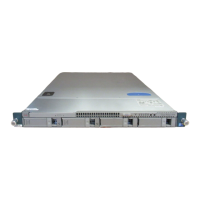22-4
Cisco Nexus 1000V Troubleshooting Guide, Release 5.2(1)SV3(1.1)
OL-31593-01
Chapter 22 System
Recovering a DVS
Step 8 Connect to vCenter Server.
Example:
switch(config-svs-conn#) connect
You can now use the old DVS or remove it.
Recovering a DVS Without a Saved Copy of the VSM
You can use this procedure to recover a DVS when you have not previously saved a back up copy of the
VSM configuration file.
BEFORE YOU BEGIN
Before starting this procedure, you must know or do the following:
• The folder in which the VSM resides must be:
–
At the root-level of the Data Center in which it resides.
It cannot be embedded in another folder.
–
Of the same name as the VSM.
If the folder does not meet the above criteria, the connection to vCenter server fails with the error,
the VSM already exists.
• Use this procedure if you have not previously saved a back up copy of the VSM configuration file.
If you have previously saved a back up copy, then see the “Recovering a DVS With a Saved Copy
of the VSM” procedure on page 22-3.
• If you have not previously saved a back up copy of the VSM configuration file, then you may try
recreating the old port profiles before connecting to the VC. This procedure has a step for recreating
port profiles. If you do not recreate these before connecting to VC, then all the port groups present
on the VC are removed and all ports in use are moved to the quarantine port groups.
• Make sure that the VSM VM switchname is the same as the DVS switchname on the vCenter Server.
This allows the VSM configuration to synchronize with the correct DVS on the vCenter Server.
To change the VSM switchname use the switchname newname command.
Step 1 From the MOB, find the DVS extension key.
For more information, see the “Finding the Extension Key Tied to a Specific DVS” procedure on
page 3-8.
Step 2 On the VSM, add the DVS extension key found in Step 1.
The extension key allows the VSM to log in to the vCenter server.
Example:
switch# config t
switch(config)# vmware vc extension-key Cisco_Nexus_1000V_32943215
Step 3 From the MOB, unregister the extension key found in Step 1.
For more information, see the “Unregistering the Extension Key in the vCenter Server” procedure on
page 3-12.
Step 4 From the VC client, register the extension (plug-in) for the VSM.

